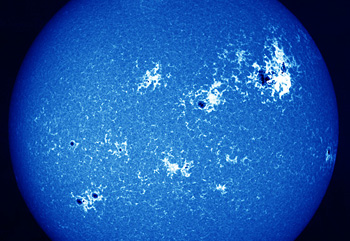DayStar is proud to offer Calcium H ( 3969Å ) and two Calcium K-line (3933.7Å ) filtering systems. Traditionally, university research has employed the Calcium K line for studies of Calcium on the Sun. These studies have been instrumental in determining depth of the solar atmosphere. Calcium offers TWO strong absorption lines at 393.3nm and at 396.9nm, known as the K and H lines. Researchers have previously avoided the H line for academic research, as it is very close to the Hydrogen Epsilon line. For purposes of clarity in isolating Calcium, and because imaging sensors offer similar sensitivity to the K as the H lines of Calcium, the K has to date been the target of choice in Calcium filters.
However, as the visual spectrum ends at approximately 400nm, the further we venture below this wavelength, the more difficult it is for observers to visually see the image. The H line for visual observations, is much closer to the visual spectrum and easier to see in high contrast violet color. Some observatories have been imaging in Ca II H line, such as the Dutch Open Telescope with outstanding results.
DayStar Calcium H-line Filter assemblies
5.0Å Single cavity visual series filter system $13,990.00
Suitible for amateur and University settings – for visual and photographic, indoor or outdoor observing settings.


Image by Dutch Open Telescope 450mm aperture telescope
Observatorio del Roque de los Muchachos • Instituto de Astrofísica de Canarias

DayStar Calcium K-line Quantum Filters
2.0Å Single cavity University series filter system $17,990.00
Suitible for academic purposes – Ideal application: with CCD photography or indoor visual viewing environment DayStar’s new Quantum controls on Calcium II K line are perfectly suited for academic studies in mapping the 3-dimensional structure of the Chromosphere. By controlling wing shift of the Ca II K line filter with precision accurate to 0.1Å, studies can depict intensity differences between the K3, K2 and K1 lines. Observation of the complicated structure of subordinate peaks offer views through different levels in the solar atmosphere.
Both Daystar Calcium H-Line and K-Line filters are available in 5Å, 2Å and 1Å FWHM.
Quotation available upon request.



DayStar 2.0 Å Calcuim K-line filtergrams taken June 8, 1982 with a 125mm aperture telescope at 3000mm prime focus.
* Note. Calcium H and K-line filters do not require F/30 configurations. They may be used at F/15 or F/20 or greater. They also do not use the same RED or Yellow glass Energy Rejection Prefilter. Rather, we recommend dielectric “hot mirror” UV/IR cut filters introduced prior to focus. Additionally, we suggest an additional neutral density solar film on apertures above 150mm or for long-term dedicated applications.
* HALF-BANDWIDTH: The term half-bandwidth refers to an optics industry standard of measure. On a chart depicting the peak where light is transmitted, that peak’s width is measured at the point 50% between zero and full transmission. This term is called half-bandwidth.

